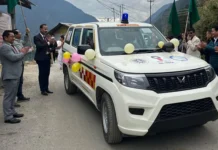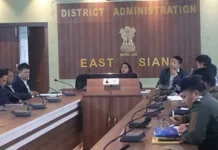Monday Musing
[ Tongam Rina ]
It’s that time of the year when land starts falling apart, torn by human interventions and the pressure of monsoon rains, visuals of destruction and death filling pages after pages of newspapers and social media.
Screaming reports in newspapers, angry posts on social media, blaming the rain and earth, followed by occasional questions why roads and homes are becoming graves for dozens and why people live in fear and uncertainty.
The first spell of monsoon has already left a trail of destruction in the state: roads disconnected, trees falling on moving vehicles and killing people, bridges swallowed by rivers, and homes destroyed.
In Itanagar, a retaining wall collapsed. The moment was captured, and it travelled far and wide on social media, shaming the government, the PWD highway and TK Engineering.
The PWD highway, known for inefficiency and corruption, straightaway blamed the engineers of the union ministry of road transport & highways (MoRTH) for engineering defects, since the ministry approved the design. The statement was promptly retracted the next day, and it was said that the MoRTH had no direct role in engineering, procurement and construction. This time the department blamed the contractor, without naming names, and the authority’s engineer, which is Noida-based M/s TAS Pvt Ltd, appointed by the MoRTH to monitor and supervise execution of works at site.
This is not the first time that a government department is going all out to hide its incompetence and negligence when the department seriously should introspect about its failings and figure out a way to improve. The capital section of the Trans-Arunachal Highway is not some nonexistent and neglected PMGSY road in an unreachable rural area of the state.
Chief Minister Pema Khandu’s prestige and chair literally were tied to the highway after he announced March 2021 as the deadline for completion of the four-lane work in the capital, minus the major culverts and bridges. The CM had set the deadline in October 2020.
The deadline was met, but the quality was compromised because everybody got busy being a yes-man and forgot to ask questions, knowing fully well that the chief minister is not a highway or structural engineer.
The retaining wall crumbled even though the chief minister himself monitors the TAH and a committee formed by his office keeps a close watch on the progress of the road.
What was the monitoring committee doing? What was and is the role of the PWD engineers? Should not they monitor the designing and execution by the contractor and the ‘authority’s engineers’? If they did, the retaining wall would not need another retaining wall. Or is it a money-minting process to watch in silence the substandard roads?
There are lessons to be learnt from earlier tragedies because of road construction gone wrong.
In July 2017, 14 people were buried alive in Laptap village in Papum Pare district after a hill along the Yupia-Seppa Trans-Arunachal Highway came down, triggering a massive landslide. Sushee Infra was carrying out earth-cutting work near the site of the accident.
In June 2018, seven people, including four Indo-Tibetan Border Police (ITBP) personnel, were killed in two different incidents when boulders fell on a Tata Sumo and an ITBP truck on the under-construction Likabali-Basar road.
Last year, in July, seven people were killed in the Itanagar capital region. The debris dumped by TK Engineering led to mudslides and landslides in Modi Rijo village, along NH 415 between Itanagar and Naharlagun, killing three.
In June this year, two died after a landslide hit a car on the BCT road in West Kameng district.
Not all deaths can be prevented, but mindless crushing of hills and mountains, and dumping of muck everywhere has led to landslides. All hill states do have the same problem, meaning that a different approach must be adopted, so that loss of life and property and defacement of nature are prevented.
The monsoon is not over yet. It is time for the state government to fix responsibility and take responsibility. The extreme reluctance to question and fix responsibility is a disease which is widespread in the state. Nobody is held accountable for deaths and destruction. Blaming nature for human inefficiency is an unforgivable excuse.



